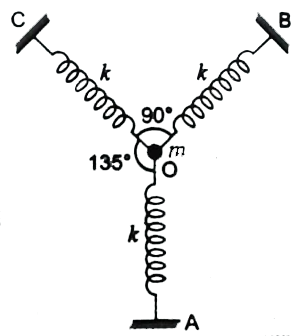A particle of mass m is attached to a spring of spring constant 'k' and has a natural frequency ω0. An external force F(t) proportional to cosωt(ω≠ω0) is applied to the oscillator. The maximum displacement of the oscillator will be proportional to
mω20+ω2
1m(ω20+ω2)
1m(ω20−ω2)
mω20−ω2
The correct Answer is:B
Topper's Solved these Questions
- OSCILLATIONSBOOK - AAKASH SERIESCHAPTER - OSCILLATIONSEXERCISE - EXERCISE II
175 Videos
- OSCILLATIONSBOOK - AAKASH SERIESCHAPTER - OSCILLATIONSEXERCISE - Practice exercise
140 Videos
- OSCILLATIONSBOOK - AAKASH SERIESCHAPTER - OSCILLATIONSEXERCISE - PROBLEM
249 Videos
- OSCILLATIONBOOK - AAKASH SERIESCHAPTER - OSCILLATIONEXERCISE - QUESTIONS FOR DESCRIPTIVE ANSWERS
12 Videos
- PHYSICAL WORLDBOOK - AAKASH SERIESCHAPTER - PHYSICAL WORLDEXERCISE - VERY SHORT ANSWER TYPE QUESTIONS
5 Videos
Similar Questions
A particle of mass (m) is attached to a spring (of spring constant k) and has a natural angular frequency ω0. An external force F(t) proportional to cosωt (ω≠ω0) is applied to the oscillator. The time displacement of the oscillator will be proportional to.
View SolutionA block of mass 'm' is attached to the light spring of force constant K and released when it is in its natural length. Find amplitude of subsequent oscillations.
View Solution
Knowledge Check
A particle of mass (m) is attached to a spring (of spring constant k) and has a natural angular frequency ω0. An external force R(t) proportional to cosωt(ω≠ω0) is applied to the oscillator. The time displacement of the oscillator will be proportional to.
Amω20−ω2B1m(ω20−ω2)C1m(ω20+ω2)Dmω20+ω2A particle of mass (m) is attached to a spring (of spring constant k) and has a narural angular frequency omega_(0). An external force R(t) proportional to cos omegat(omega!=omega)(0) is applied to the oscillator. The time displacement of the oscillator will be proprtional to.
A(a) 1m(ω20+ω2)B(b) 1ω(ω20−ω2)C(c ) mω20−ω2D(d) mom20+ω2A particle of mass m is attached to three identical springs of spring constant k as shwon in figure. The time period of vertical oscillation of the particle is
 A2π√mkB2π√m2kC2π√m3kDπ√mk
A2π√mkB2π√m2kC2π√m3kDπ√mk
A particle of mass m is attached to three identical massless springs of spring constant k as shown in the m 135 figure. The time period of vertical oscillation of the particle is

View SolutionAn object of mass m, oscillating on the end of a spring with spring constant k has amplitude A. its maximum speed is
View SolutionA load of mass M is attached to the bottom of a spring of mass 'M/3' and spring constant 'K'. If the system is set into oscillation, the time period of oscillation is
View SolutionThe natural frequency (ω0) of oscillations in LC circuit is given by
View SolutionThe natural frequency (ω0) of oscillations in LC circuit is given by
View Solution
